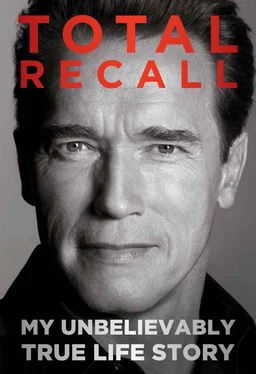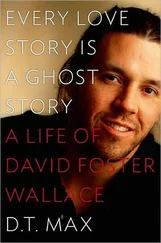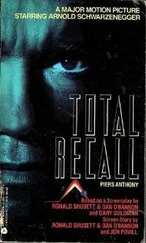Coming up with outrageous things to say was easy because I was always thinking them to keep myself entertained. Besides, George was egging me on. During one interview, I made bodybuilding sound sexy by comparing the pump, when you inflate your muscles with oxygenated blood, to an orgasm. I claimed I’d skipped my father’s funeral because it would have interfered with my training. I philosophized that only a few men are born to lead, while the rest of humanity is born to follow, and went from that into discussing history’s great conquerors and dictators. George had the good sense to cut such stuff from the movie, especially my remark that I admired Hitler’s speaking ability, though not what he did with it. I still didn’t know the difference between outlandish and offensive.
It was stressful having the cameras on me all the time: not just when I was working out but also when I was at home, visiting friends, attending business school or acting class, evaluating real estate, reading scripts. Again, I was grateful for Transcendental Meditation, especially because the TM centers wouldn’t allow cameras inside.
Putting the psych on Lou and his father was part of the drama for the movie. I started setting them up that autumn by pretending to be scared.
“I hope that you screw up your training,” I told Lou’s father. “Otherwise he’s going to be very dangerous for me at the Olympia.”
“Oh, we’re not going to screw anything up.”
Lou himself was easy to rattle, like Sergio Oliva, Dennis Tinerino, or any of the bodybuilders who were so inward that they’d didn’t pay that much attention to the world. You could say casually to Lou, “How have you been doing with your abs?”
And he’d say, “Fine. Why? Actually, I feel pretty ripped.”
“Well, it’s … No, never mind, don’t worry about it, they look great.” As you said it, he’d start looking at his abs, and then afterward, Lou would pose in the mirror as the insecurity took hold.
You can see in Pumping Iron how I kept teasing him and his dad right up to the moment of the competition. Like when I tell Lou, “I already called my mother and I told her that I won, even though the competition is tomorrow.” Or, on the morning of the event, when he and his parents invite me to breakfast at the hotel, and I say, “I can’t believe this. You ignore me all week, and now you want to have breakfast on the morning of the competition? You are trying to psych me out!” I pretend I’m so scared that my scrambled egg is shaking on my fork. All this was mainly show, so that audiences would walk away from Pumping Iron saying, “Can you believe that guy? He literally talked his opponent into losing.” But it also had its effect on Lou, who came in third as I won the Mr. Olympia title for a record sixth time straight.
PUMPING IRON WAS ONLYhalf finished, and George was out of cash. Rather than give up on the project, he hit on the idea of staging a posing exhibition in a New York City art museum to try to attract wealthy patrons. We weren’t sure whether this idea was stupid or really brilliant. The Whitney Museum of American Art, which was known for unconventional stuff, leaped at the opportunity.
The event was advertised as Articulate Muscle: The Male Body in Art , and the museum stayed open to host it on a Friday night in February 1976. The idea was to present live posing by Frank Zane, Ed Corney, and me next to slides of Greek statues and great works by Michelangelo, da Vinci, and Rodin. A panel of professors and artists would add commentary along the way and afterward. This was the first time anyone had a serious public discussion about the meaning of bodybuilding.
George was hoping for a few hundred people, but despite a snowstorm that night, more than 2,500 showed up and the line stretched around the block. The museum’s fourth-floor gallery overflowed with people standing and sitting on every inch of floor space. In the middle was a raised, revolving platform on which we were to take turns posing.
Probably two-thirds of the crowd had never even seen a bodybuilder before. They were from the media and the New York art scene: critics, collectors, patrons, and avant-garde artists like Andy Warhol and Robert Mapplethorpe. People magazine, The New Yorker , the New York Times , and the Daily News all had reporters there, and actress Candice Bergen was shooting photographs for the Today show. She was a great photographer and of course very beautiful. All of sudden, bodybuilding was hip. We’d made it out of the sports world and the carnival world and into international pop culture.
Frank, Ed, and I were proud to be posing at a real museum. We’d planned our exhibition to be artistic, leaving out hard-core bodybuilding poses like the “most muscular.” We wanted each pose to look like a sculpture, especially because we were on a rotating platform. When my turn came, Charles Gaines narrated as I hit the standard shots and showed off some of my trademark poses, like the three-quarters back shot. Gaines said, “Arnold owns this pose. And in it you see all the muscles in the back; you see the calf; you see all the thigh muscles.” I wrapped up my ten minutes with a perfect simulation of The Thinker by Rodin and got a lot of applause.
We put on our clothes after we finished posing and went back out and joined the discussion with the art experts. Their talks were fascinating, in a way. For one thing, they showed that you can make a debate out of anything. One professor said this gathering marked “the entry of the highly developed, beautiful masculine form into the sphere of official culture.” The next guy thought that because of Vietnam, America was looking for a new definition of virility, which was us. But then he tied bodybuilding to Aryan racism in 1920s Europe and the rise of the Nazis and warned that we symbolized the possible growth of fascism in the United States. Another professor compared our poses to the worst Victorian-era kitsch. He got booed.
The whole thing was mainly a publicity stunt, of course. But I thought that talking about the body as sculpture made sense. My Joe Santo character in Stay Hungry described it that way. Art fascinated me, and if the comparison to sculpture attracted outsiders and helped them understand, then great! Anything was better than the stereotype of bodybuilders as stupid, gay, narcissistic, muscle-bound freaks.
Unfortunately, much less was happening in Hollywood than in New York. Stay Hungry was my first experience in how movie marketing can go wrong. Upon the film’s April release, it received good reviews but fizzled at the box office, playing for ten or twelve weeks before disappearing. The problem was that the publicists and marketing people at United Artists could not figure out how to promote it. Rafelson let me sit in on a meeting before the release, and they were talking about putting posters in gyms. Then when the film came out, they had Sally Field and me on The Mike Douglas Show showing the fifty-year-old host how to exercise. Each time we did something like that, I felt like we were moving in the wrong direction. Stay Hungry should have been sold as a Bob Rafelson picture—“from the director of Five Easy Pieces !”—and they should have let the exercise dimension be a surprise. Then moviegoers would have walked away saying, “That’s Rafelson. He always introduces us to some weird world.”
Although my instincts told me that the marketing was embarrassing, I didn’t have the sophistication or confidence to say it. I assumed that the studio would have its act together much more. Of course, later on, I realized that studios work by formulas. If you’re even a little outside the box, they don’t know what to do with you.
Читать дальше












